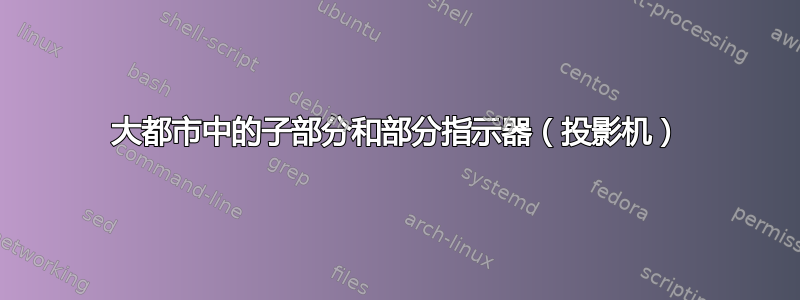
我添加了部分指示符按照这个答案。但是,当我有一个包含两个小节的部分时,似乎我有三个级别,如下所示:
我基本上总是无缘无故地多一个级别。
要重新创建此功能,您可以使用官方大都市模板,添加一个小节和我上面提到的答案中建议的部分指示符代码。
这里有您可以简单复制和粘贴的所有代码,但这只是上述过程的结果。
\documentclass[10pt]{beamer}
\usetheme[progressbar=frametitle]{metropolis}
\usepackage{appendixnumberbeamer}
\usepackage{booktabs}
\usepackage[scale=2]{ccicons}
\usepackage{pgfplots}
\usepgfplotslibrary{dateplot}
\usepackage{xspace}
\newcommand{\themename}{\textbf{\textsc{metropolis}}\xspace}
\makeatletter
\setbeamertemplate{headline}{%
\begin{beamercolorbox}[colsep=1.5pt]{upper separation line head}
\end{beamercolorbox}
\begin{beamercolorbox}{section in head/foot}
\vskip2pt\insertnavigation{\paperwidth}\vskip2pt
\end{beamercolorbox}%
\begin{beamercolorbox}[colsep=1.5pt]{lower separation line head}
\end{beamercolorbox}
}
\makeatother
\title{Metropolis}
\subtitle{A modern beamer theme}
% \date{\today}
\date{}
\author{Matthias Vogelgesang}
\institute{Center for modern beamer themes}
% \titlegraphic{\hfill\includegraphics[height=1.5cm]{logo.pdf}}
\begin{document}
\maketitle
\begin{frame}{Table of contents}
\setbeamertemplate{section in toc}[sections numbered]
\tableofcontents%[hideallsubsections]
\end{frame}
\section[Intro]{Introduction}
\begin{frame}[fragile]{Metropolis}
The \themename theme is a Beamer theme with minimal visual noise
inspired by the \href{https://github.com/hsrmbeamertheme/hsrmbeamertheme}{\textsc{hsrm} Beamer
Theme} by Benjamin Weiss.
Enable the theme by loading
\begin{verbatim} \documentclass{beamer}
\usetheme{metropolis}\end{verbatim}
Note, that you have to have Mozilla's \emph{Fira Sans} font and XeTeX
installed to enjoy this wonderful typography.
\end{frame}
\begin{frame}[fragile]{Sections}
Sections group slides of the same topic
\begin{verbatim} \section{Elements}\end{verbatim}
for which \themename provides a nice progress indicator \ldots
\end{frame}
\section{Titleformats}
\subsection{A subsection}
\begin{frame}{Metropolis titleformats}
\themename supports 4 different titleformats:
\begin{itemize}
\item Regular
\item \textsc{Smallcaps}
\item \textsc{allsmallcaps}
\item ALLCAPS
\end{itemize}
They can either be set at once for every title type or individually.
\end{frame}
\subsection{Tricks}
{
\metroset{titleformat frame=smallcaps}
\begin{frame}{Small caps}
This frame uses the \texttt{smallcaps} titleformat.
\begin{alertblock}{Potential Problems}
Be aware, that not every font supports small caps. If for example you typeset your presentation with pdfTeX and the Computer Modern Sans Serif font, every text in smallcaps will be typeset with the Computer Modern Serif font instead.
\end{alertblock}
\end{frame}
}
{
\metroset{titleformat frame=allsmallcaps}
\begin{frame}{All small caps}
This frame uses the \texttt{allsmallcaps} titleformat.
\begin{alertblock}{Potential problems}
As this titleformat also uses smallcaps you face the same problems as with the \texttt{smallcaps} titleformat. Additionally this format can cause some other problems. Please refer to the documentation if you consider using it.
As a rule of thumb: Just use it for plaintext-only titles.
\end{alertblock}
\end{frame}
}
{
\metroset{titleformat frame=allcaps}
\begin{frame}{All caps}
This frame uses the \texttt{allcaps} titleformat.
\begin{alertblock}{Potential Problems}
This titleformat is not as problematic as the \texttt{allsmallcaps} format, but basically suffers from the same deficiencies. So please have a look at the documentation if you want to use it.
\end{alertblock}
\end{frame}
}
\section{Elements}
\begin{frame}[fragile]{Typography}
\begin{verbatim}The theme provides sensible defaults to
\emph{emphasize} text, \alert{accent} parts
or show \textbf{bold} results.\end{verbatim}
\begin{center}becomes\end{center}
The theme provides sensible defaults to \emph{emphasize} text,
\alert{accent} parts or show \textbf{bold} results.
\end{frame}
\begin{frame}{Font feature test}
\begin{itemize}
\item Regular
\item \textit{Italic}
\item \textsc{SmallCaps}
\item \textbf{Bold}
\item \textbf{\textit{Bold Italic}}
\item \textbf{\textsc{Bold SmallCaps}}
\item \texttt{Monospace}
\item \texttt{\textit{Monospace Italic}}
\item \texttt{\textbf{Monospace Bold}}
\item \texttt{\textbf{\textit{Monospace Bold Italic}}}
\end{itemize}
\end{frame}
\begin{frame}{Lists}
\begin{columns}[T,onlytextwidth]
\column{0.33\textwidth}
Items
\begin{itemize}
\item Milk \item Eggs \item Potatos
\end{itemize}
\column{0.33\textwidth}
Enumerations
\begin{enumerate}
\item First, \item Second and \item Last.
\end{enumerate}
\column{0.33\textwidth}
Descriptions
\begin{description}
\item[PowerPoint] Meeh. \item[Beamer] Yeeeha.
\end{description}
\end{columns}
\end{frame}
\begin{frame}{Animation}
\begin{itemize}[<+- | alert@+>]
\item \alert<4>{This is\only<4>{ really} important}
\item Now this
\item And now this
\end{itemize}
\end{frame}
\begin{frame}{Figures}
\begin{figure}
\newcounter{density}
\setcounter{density}{20}
\begin{tikzpicture}
\def\couleur{alerted text.fg}
\path[coordinate] (0,0) coordinate(A)
++( 90:5cm) coordinate(B)
++(0:5cm) coordinate(C)
++(-90:5cm) coordinate(D);
\draw[fill=\couleur!\thedensity] (A) -- (B) -- (C) --(D) -- cycle;
\foreach \x in {1,...,40}{%
\pgfmathsetcounter{density}{\thedensity+20}
\setcounter{density}{\thedensity}
\path[coordinate] coordinate(X) at (A){};
\path[coordinate] (A) -- (B) coordinate[pos=.10](A)
-- (C) coordinate[pos=.10](B)
-- (D) coordinate[pos=.10](C)
-- (X) coordinate[pos=.10](D);
\draw[fill=\couleur!\thedensity] (A)--(B)--(C)-- (D) -- cycle;
}
\end{tikzpicture}
\caption{Rotated square from
\href{http://www.texample.net/tikz/examples/rotated-polygons/}{texample.net}.}
\end{figure}
\end{frame}
\begin{frame}{Tables}
\begin{table}
\caption{Largest cities in the world (source: Wikipedia)}
\begin{tabular}{lr}
\toprule
City & Population\\
\midrule
Mexico City & 20,116,842\\
Shanghai & 19,210,000\\
Peking & 15,796,450\\
Istanbul & 14,160,467\\
\bottomrule
\end{tabular}
\end{table}
\end{frame}
\begin{frame}{Blocks}
Three different block environments are pre-defined and may be styled with an
optional background color.
\begin{columns}[T,onlytextwidth]
\column{0.5\textwidth}
\begin{block}{Default}
Block content.
\end{block}
\begin{alertblock}{Alert}
Block content.
\end{alertblock}
\begin{exampleblock}{Example}
Block content.
\end{exampleblock}
\column{0.5\textwidth}
\metroset{block=fill}
\begin{block}{Default}
Block content.
\end{block}
\begin{alertblock}{Alert}
Block content.
\end{alertblock}
\begin{exampleblock}{Example}
Block content.
\end{exampleblock}
\end{columns}
\end{frame}
\begin{frame}{Math}
\begin{equation*}
e = \lim_{n\to \infty} \left(1 + \frac{1}{n}\right)^n
\end{equation*}
\end{frame}
\begin{frame}{Line plots}
\begin{figure}
\begin{tikzpicture}
\begin{axis}[
mlineplot,
width=0.9\textwidth,
height=6cm,
]
\addplot {sin(deg(x))};
\addplot+[samples=100] {sin(deg(2*x))};
\end{axis}
\end{tikzpicture}
\end{figure}
\end{frame}
\begin{frame}{Bar charts}
\begin{figure}
\begin{tikzpicture}
\begin{axis}[
mbarplot,
xlabel={Foo},
ylabel={Bar},
width=0.9\textwidth,
height=6cm,
]
\addplot plot coordinates {(1, 20) (2, 25) (3, 22.4) (4, 12.4)};
\addplot plot coordinates {(1, 18) (2, 24) (3, 23.5) (4, 13.2)};
\addplot plot coordinates {(1, 10) (2, 19) (3, 25) (4, 15.2)};
\legend{lorem, ipsum, dolor}
\end{axis}
\end{tikzpicture}
\end{figure}
\end{frame}
\begin{frame}{Quotes}
\begin{quote}
Veni, Vidi, Vici
\end{quote}
\end{frame}
{%
\setbeamertemplate{frame footer}{My custom footer}
\begin{frame}[fragile]{Frame footer}
\themename defines a custom beamer template to add a text to the footer. It can be set via
\begin{verbatim}\setbeamertemplate{frame footer}{My custom footer}\end{verbatim}
\end{frame}
}
\begin{frame}{References}
Some references to showcase [allowframebreaks] \cite{knuth92,ConcreteMath,Simpson,Er01,greenwade93}
\end{frame}
\section{Conclusion}
\begin{frame}{Summary}
Get the source of this theme and the demo presentation from
\begin{center}\url{github.com/matze/mtheme}\end{center}
The theme \emph{itself} is licensed under a
\href{http://creativecommons.org/licenses/by-sa/4.0/}{Creative Commons
Attribution-ShareAlike 4.0 International License}.
\begin{center}\ccbysa\end{center}
\end{frame}
{\setbeamercolor{palette primary}{fg=black, bg=yellow}
\begin{frame}[standout]
Questions?
\end{frame}
}
\appendix
\begin{frame}[fragile]{Backup slides}
Sometimes, it is useful to add slides at the end of your presentation to
refer to during audience questions.
The best way to do this is to include the \verb|appendixnumberbeamer|
package in your preamble and call \verb|\appendix| before your backup slides.
\themename will automatically turn off slide numbering and progress bars for
slides in the appendix.
\end{frame}
\begin{frame}[allowframebreaks]{References}
\bibliography{demo}
\bibliographystyle{abbrv}
\end{frame}
\end{document}
答案1
这是预期的默认行为,可以通过传递compress给beamer类(\documentclass[compress]{beamer})进行配置。
请注意,默认情况下,圆圈的行数代表节下的子节数,而不是节级别。
为什么预期的行为:
beamer包装手册(pdf), 第 16.2 节“外部主题”,外部主题的文档miniframes内容如下(粗体由我添加)此主题安装了一个标题,其中显示了一个水平导航栏。此栏包含演示文稿的每个部分的一个条目。在每个部分条目下方,会显示小圆圈,代表该部分中的不同框架。这些框架按子部分排列,即每个小节都有一行框架。如果指定了 class 选项
compress,框架将改为按每个部分排列成一行。导航栏的颜色取自section in head/foot。为什么与外部主题相关
miniframe:因为设定
\setbeamertemplate{headline}{...}只是摘录自外传miniframe(beamerouterthememiniframes.sty)链接的第一段也提到了这一点samcarter 的回答。
一个简化的例子:
\documentclass[compress]{beamer}
\makeatletter
\setbeamertemplate{headline}{%
\begin{beamercolorbox}[colsep=1.5pt]{upper separation line head}
\end{beamercolorbox}
\begin{beamercolorbox}{section in head/foot}
\vskip2pt\insertnavigation{\paperwidth}\vskip2pt
\end{beamercolorbox}%
\begin{beamercolorbox}[colsep=1.5pt]{lower separation line head}
\end{beamercolorbox}
}
\makeatother
\setbeamercolor{section in head/foot}{fg=normal text.bg, bg=structure.fg}
\begin{document}
\section{section 1}
\subsection{section 1} \frame{}
\subsection{title} \frame{}\frame{}
\subsection{title} \frame{}\frame{}\frame{}
\section{section 2} \frame{}\frame{}
\section{section 3} \frame{}\frame{}\frame{}
\end{document}
没有compress
和compress





